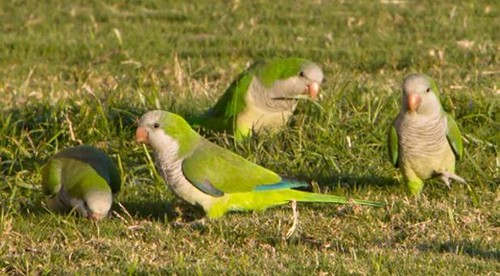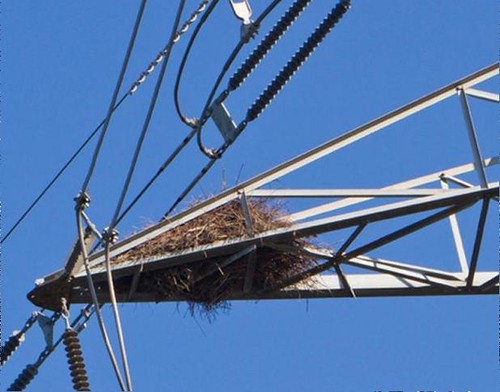 Monk Parakeets. Photo Jim WeberEstablished in Austin in the early 1970s from escaped caged birds, Monk parakeets (Myiopsitta monachus) also known as Quaker parrots, are native to the temperate and subtropical regions of Argentina and surrounding countries in South America. "Monks" are often heard before they are seen, as their call is a loud and throaty chap(-yee), or quak quaki quak-wi quarr, and their sometimes startling screeches sound like skveet! They have grown in numbers by being able to survive our mild winters, and as such have now been included on the official list of accepted Texas bird species.
Monk Parakeets. Photo Jim WeberEstablished in Austin in the early 1970s from escaped caged birds, Monk parakeets (Myiopsitta monachus) also known as Quaker parrots, are native to the temperate and subtropical regions of Argentina and surrounding countries in South America. "Monks" are often heard before they are seen, as their call is a loud and throaty chap(-yee), or quak quaki quak-wi quarr, and their sometimes startling screeches sound like skveet! They have grown in numbers by being able to survive our mild winters, and as such have now been included on the official list of accepted Texas bird species.
A colorful bird with bright green upper parts, pale gray forehead and breast with darker scalloped edges, and very light green to yellow under parts, Monks also have an orange bill, stiff dark blue flight feathers and a long tapered tail. Technically a parrot, it is this tail that makes them a parakeet, which is a term for small- to medium-sized species of parrots that generally have long tail feathers.
 Stick nest of Monk Parakeet. Photo Jim WeberMonks are the only parrots that build a stick nest, either in a tall tree or manmade structure, rather than using an existing hole in a tree. They often breed in colonies, building a single large nest that has separate entrance holes for each pair. In the wild these colonies can become quite large, with communal nests reaching the size of a small automobile.
Stick nest of Monk Parakeet. Photo Jim WeberMonks are the only parrots that build a stick nest, either in a tall tree or manmade structure, rather than using an existing hole in a tree. They often breed in colonies, building a single large nest that has separate entrance holes for each pair. In the wild these colonies can become quite large, with communal nests reaching the size of a small automobile.
Also unusual for a parrot, these birds occasionally have "helper individuals," typically grown offspring, who assist in feeding the young. Highly intelligent and social birds, Monks can live anywhere from 15 to 30 years, and like parrots kept as pets, they develop a large vocabulary.
Monk parakeets readily adapt to urban neighborhoods, as they are an open woodland species. A recent informal survey found more than 65 nests in Austin, mostly in cellphone towers, tall telephone poles and sports facility light poles.
Even if the nests are cleared out, many colonies return to the same place to rebuild their nest. While mainly constructed out of willow branches, these nests might include manmade items such as rope, carpet, newspaper and scraps of cloth. The Monks' diet consists of berries, tree buds and seeds, all of which can be plentiful in native and nonnative tree species common in the Austin area.
The exact number of wild Monks in our area is unknown, and evidence of harm by feral colonies of Monks is disputed. While they can be agricultural pests by eating fruits, grains and other crops, they also can benefit local economies through birdwatching-based ecotourism. It is also important to remember that tens of millions of parrots have been removed from the wild worldwide, and have been traded in greater numbers and for far longer than any other group of wild animals. Many parrot species are still threatened by this trade, as well as by habitat loss, predation by introduced species, and hunting for food or feathers.
As such, let's respect their existence and enjoy our parakeets.